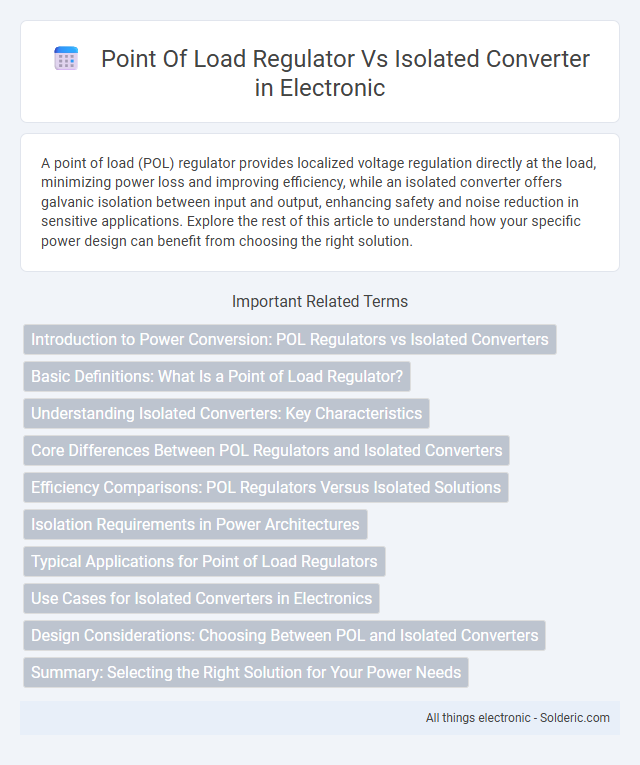A point of load (POL) regulator provides localized voltage regulation directly at the load, minimizing power loss and improving efficiency, while an isolated converter offers galvanic isolation between input and output, enhancing safety and noise reduction in sensitive applications. Explore the rest of this article to understand how your specific power design can benefit from choosing the right solution.
Comparison Table
| Feature | Point of Load (POL) Regulator | Isolated Converter |
|---|---|---|
| Function | Steps down voltage locally near the load. | Provides galvanic isolation and voltage conversion. |
| Isolation | No electrical isolation. | Provides electrical isolation between input and output. |
| Application | Used for point-specific voltage regulation in digital circuits. | Used in systems requiring safety isolation or noise reduction. |
| Efficiency | High efficiency due to minimal voltage conversion steps. | Moderate efficiency; includes isolation transformer losses. |
| Size | Compact and small footprint for PCB integration. | Typically larger due to isolation components. |
| Cost | Lower cost for non-isolated point-of-load regulation. | Higher cost because of isolation and safety features. |
| Complexity | Simple design with fewer components. | More complex design with transformers and control circuits. |
Introduction to Power Conversion: POL Regulators vs Isolated Converters
Point of Load (POL) regulators provide efficient voltage regulation near the load, minimizing distribution losses and enabling faster transient response in distributed power systems. Isolated converters incorporate galvanic isolation to protect sensitive electronics and reduce noise interference, making them essential in applications requiring safety and electrical separation. Selecting between POL regulators and isolated converters depends on factors like system architecture, isolation requirements, and efficiency targets.
Basic Definitions: What Is a Point of Load Regulator?
A Point of Load (POL) regulator is a compact voltage regulator positioned close to the load, designed to efficiently convert and regulate power to a specific voltage required by electronic components. Unlike isolated converters that provide galvanic isolation between input and output for safety and noise reduction, POL regulators focus on minimizing voltage drop and delivering precise power at the component level. Your choice between a POL regulator and an isolated converter depends on factors like power efficiency, space constraints, and isolation needs.
Understanding Isolated Converters: Key Characteristics
Isolated converters feature galvanic isolation between input and output, enhancing safety and noise reduction in sensitive electronic applications. They typically use transformers to transfer energy, enabling different voltage levels and ground references, which is essential in medical, industrial, and communication systems. This isolation also prevents ground loops and allows multiple outputs with independent grounds, distinguishing them from point of load regulators that directly regulate voltage without isolation.
Core Differences Between POL Regulators and Isolated Converters
Point of Load (POL) regulators directly step down voltage close to the load, offering high efficiency and fast transient response due to their non-isolated design. Isolated converters provide galvanic isolation between input and output, enhancing safety and noise immunity, which is critical in applications requiring voltage level shifting or stringent isolation standards. POL regulators typically prioritize compact integration and low output ripple, whereas isolated converters emphasize isolation, robustness, and the ability to handle wide input ranges in complex power systems.
Efficiency Comparisons: POL Regulators Versus Isolated Solutions
Point of load (POL) regulators typically offer higher efficiency than isolated converters due to their direct voltage regulation near the load, minimizing power losses associated with isolation transformers. Isolated converters, while essential for safety and noise reduction, often incur additional losses from isolation barriers and transformer windings, reducing overall efficiency. Your choice depends on whether efficiency or galvanic isolation is the priority in your application.
Isolation Requirements in Power Architectures
Point of load (POL) regulators typically lack galvanic isolation, making them suitable for applications where isolation is provided at higher levels in the power architecture. Isolated converters offer galvanic isolation between input and output, essential for meeting safety standards, noise reduction, and ground loop prevention in complex systems. Choosing between POL regulators and isolated converters depends on the required isolation level dictated by system safety, electromagnetic compatibility, and design constraints.
Typical Applications for Point of Load Regulators
Point of load regulators are commonly used in applications requiring precise voltage regulation near sensitive components, such as microprocessors, FPGAs, and ASICs in data centers and telecommunications equipment. They offer efficient power delivery directly where the load is, minimizing power loss and improving overall system performance in complex electronics. Your designs benefit from enhanced transient response and reduced noise, critical for high-speed digital circuits and memory modules.
Use Cases for Isolated Converters in Electronics
Isolated converters provide electrical isolation between input and output, making them ideal for sensitive electronics requiring noise reduction and safety compliance. Common use cases include medical devices, industrial control systems, and communication equipment where preventing ground loops and protecting against voltage spikes is critical. Your electronic designs benefit from isolated converters when safety standards and signal integrity are essential considerations.
Design Considerations: Choosing Between POL and Isolated Converters
Point of load (POL) regulators offer compact, high-efficiency power delivery with minimal voltage drop, making them ideal for applications requiring tight voltage regulation near the load. Isolated converters provide galvanic isolation, essential for safety, noise reduction, and meeting regulatory standards in complex systems with multiple ground domains. Design considerations hinge on factors like electrical isolation requirements, space constraints, efficiency goals, and the need for minimizing electromagnetic interference.
Summary: Selecting the Right Solution for Your Power Needs
Point of load regulators offer efficient voltage stepping close to the load with minimal noise and fast transient response, ideal for compact and sensitive electronics. Isolated converters provide galvanic isolation, ensuring safety and noise immunity in applications requiring separation between input and output grounds. Your choice depends on whether efficiency and size or isolation and safety are the primary priorities for your power design.
point of load regulator vs isolated converter Infographic

 solderic.com
solderic.com